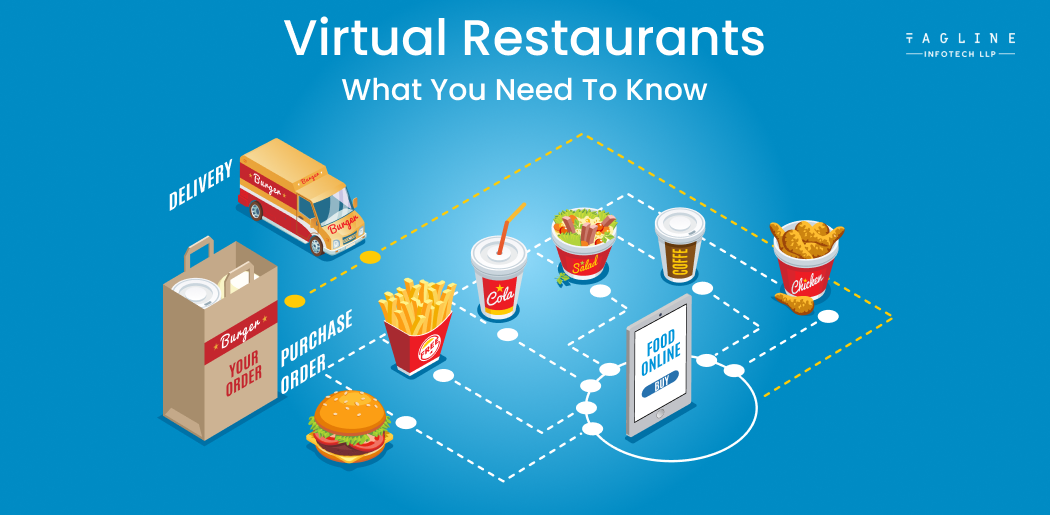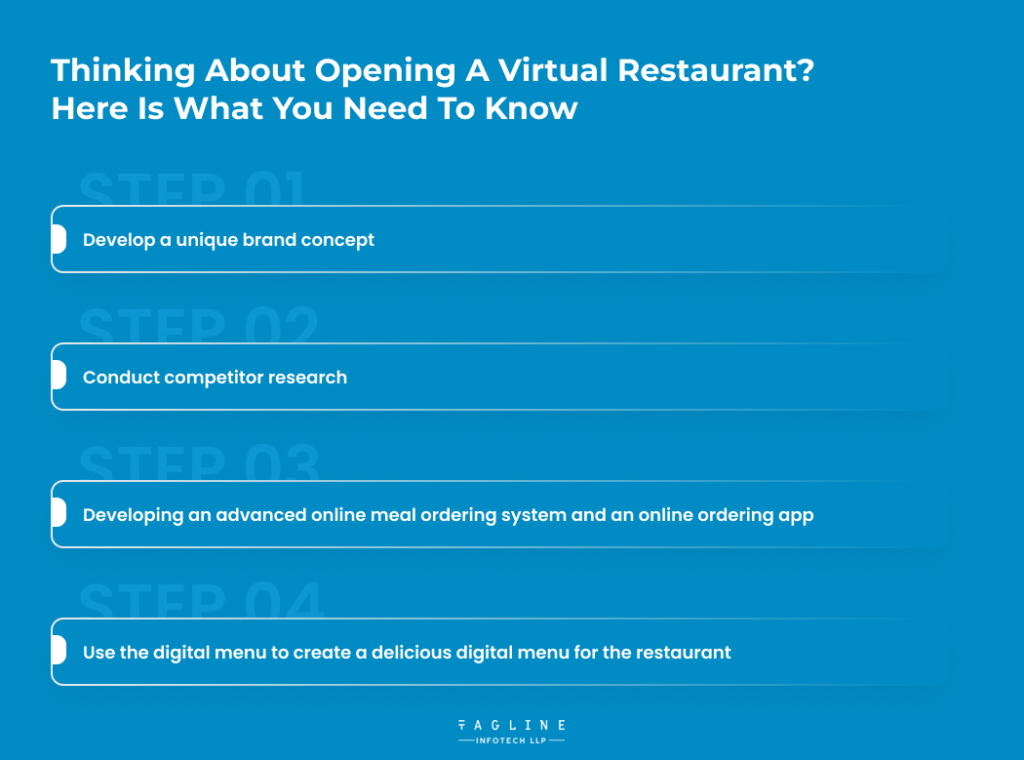React Native Vs. Native: Which Is Best For...
April 29, 2024
Home >> Restaurant >> Virtual Restaurants: What You Need To Know

Quick Summary
Ordering food delivery and takeout online from restaurants The revolution started long before the epidemic’s housing restrictions, and it was accompanied by a craving for delicious meals delivered from favorite restaurants. Despite this, the pandemic has substantially accelerated it, and it has added safety to the list of factors driving the expansion of food delivery services. There is a great deal of commercial potential for gourmands in this industry, as evidenced by the fact that most people can now enjoy the convenience of having their favorite foods delivered right to their door.
Envision a location where food is prepared and subsequently dispatched to certain areas. It appears that you are at a virtual restaurant. In other words, a virtual restaurant does not have any options for dine-in patrons and only provides delivery services. These restaurants use a variety of techniques, including third-party food aggregators, on-location food delivery apps, cloud kitchen websites, and others, to process, deliver, and/or retrieve client orders. The restaurant can be located anywhere you think is suitable for its location, as it is not limited to a traditional dining area. It is essentially simply a virtual kitchen. Although food trucks can serve as online eateries, they don’t always need to be in one place.
Entering a market that is loaded with expansion potential is a competitive advantage, especially because it is expected that the food delivery business will develop exponentially in the next years. Virtual restaurants have a lot of other benefits in addition to this one and the fact that they save a lot of money on expenses:
Low Capital Investment: It is clear that a front house area, extra servers and service staff, infrastructure, tableware, guest restrooms, and a host of other necessities that are necessary for a typical restaurant are not needed when there are no dine-in customers. Just try to imagine how much that could set you back, and remember that the idea of eating virtually is saving you a significant amount of money.
Flexible Operations: Since you do not maintain hard copies of your menu, you may quickly and readily make changes to it without bothering your customers again. Changing your digital menu is all that is needed from you.
Bigger Audience: When you have a dine-in restaurant, your customer base is mainly restricted to the areas that are near your business. However, due to the online meal ordering system, you can draw in a larger customer base while operating a virtual restaurant.
“Top 10 food app ideas that can be profitable for restaurants “
– Also Read Article

Your restaurant must stand out in the modern world of endless options if you want to succeed and be considered seriously. Knowing this, the first thing you should do before opening a virtual restaurant is to thoroughly record your business’s concept. It is crucial to start with a clear idea of everything, including finances, location, and the type of virtual restaurant you want to operate.
You must choose what it is that you will offer. Whether you want an extensive menu like Absolute Brands or a limited menu like It’s Just Wings, it must be carefully considered and, of course, visually appealing and unique.
Create a brand – Everything about your online restaurant, such as the name, logo, menu, and services, should have a branding prop.
Establish a Menu – The idea you’ve presented must be reflected in your menu. Make sure everything is of the greatest caliber, including the names, the look, and—above all—the flavor.
Determine Price Points – Adopt a realistic stance and make sure that your product’s price range is both reasonable for your buyers and compatible with your costs.
One of the hardest obstacles to overcome is developing the concept and building a brand. If you can successfully create a documented version of your online restaurant, you have already made great strides toward your objective.
To become greater than the greatest, one must first study the finest. Make a shortlist of the best online eateries that cater to the same clientele and sell comparable goods, then research their strategies, USPs, and other details. commit the most of their positive traits and be careful not to commit the mistakes they may be attempting to avoid. Investigate and evaluate the actions of the top companies in the industry.
It is impossible to overestimate the significance of an online meal ordering system in a virtual restaurant relative to the cuisine. Your customers need a way to get in touch with you when they wish to order food. The bridge in issue may be your restaurant’s website, your food ordering app, or a third-party meal delivery service that you could collaborate with. Making sure the bridge is as effective as possible is crucial if you want to build a strong relationship with your customers. Some of the several possibilities the system offers for you to choose from are as follows:
Virtual Restaurant Website – Create an eye-catching, user-friendly, secure, and comprehensive website for your restaurant that is also safe and secure. You should research the cost of creating a high-quality website for your virtual restaurant if you wish to do so.
The safest website creator for eateries
Application for Virtual Restaurant Food Ordering and Delivery: If you want to draw in more customers, you can think about investing in a custom application for your virtual restaurant that has a range of features and the newest technology. By employing pre-made restaurant food aggregator software, you may market your business quickly. If you don’t want to invest a lot of time creating unique meal delivery apps, this is one possibility.
First and foremost, the temptation displayed on your menu will be the primary driver of sales for your virtual restaurant. Make a digital menu for the restaurant that is incredibly comprehensive, gorgeous, delicious, and all-inclusive.
On the menu, you should have scrumptious photos of your dishes. Everyone gives in to the oozing chocolate, the exploding cheese, the expanding vegetables, and the sight of everything delectable and aromatic on their screens.
You must provide the visitor with a thorough and persuasive description of the products to persuade them to become buyers. You can have a cheese pizza, or a sizzling pizza with bursting cheese and unusual toppings, if you’d like.
Give customers several ways to customize the dishes: add-ons, toppings, sauces, and more.
You need to maintain a competitive price point if you want to keep your consumers.
Offer new promotions and discounts regularly to get your customers to come back to the things they love the most.
You will start running special promotions to advertise your online restaurant in the fifth step. website for the restaurant and eatery
Naturally, the most crucial element in determining success is promotion, followed by excellent taste and services. Still, you need to keep creating buzz about your virtual restaurant if you want the greatest results. Here are a few tried-and-true strategies you can use to sell your company successfully.
Adding posts that include calls to action, creating polls, publishing from your accounts, and other comparable actions are ways to increase your company’s social network presence.
To ensure that your Google Business Profile is easily available through searches and seen by a larger audience, make sure it is updated.
To enhance the quantity of clients you retain, you must use customized offers and email marketing.
Looking to create the perfect virtual restaurant?
Connect with our developer team for a customized and efficient development journey. Let’s build something extraordinary together!
Individuals who have a strong passion for the food sector but need financial support to risk a substantial amount of money can think about starting a virtual restaurant. Capitalize on the increasing demand for food delivery services by offering top-notch services, putting in place a reliable online meal delivery system, and using efficient marketing. A good meal delivery app and a well-designed website for your online eatery will help you increase the effectiveness of your business. Consider partnering with a leading Restaurant App Solution Development Company for tailored solutions that elevate the effectiveness of your online eatery.
Virtual Restaurant is a restaurant that has a full menu but doesn’t have its own space. These restaurants use a shared kitchen with another business to cook their food.
If you are thinking about opening a virtual restaurant then let me tell you it is the best idea because it is a convenient option for you whenever you are trying to start your business or trying to expand it.

Digital Valley, 423, Apple Square, beside Lajamni Chowk, Mota Varachha, Surat, Gujarat 394101
+91 9913 808 2851133 Sampley Ln Leander, Texas, 78641
52 Godalming Avenue, wallington, London - SM6 8NW